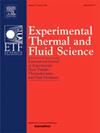空气、雾/空气和蒸汽膜在单排孔和双排孔平板上冷却的实验研究
IF 3.3
2区 工程技术
Q2 ENGINEERING, MECHANICAL
Experimental Thermal and Fluid Science
Pub Date : 2025-06-28
DOI:10.1016/j.expthermflusci.2025.111559
引用次数: 0
摘要
雾/空气冷却作为一种改进传统空气冷却的新技术,已经得到了广泛的研究。然而,以往的实验研究仅限于相对较低的主流温度,导致雾蒸发不完全。本研究首次对高达460 K的高温主流条件下的雾/气膜冷却进行了实验研究,重点研究了吹风比(0.5-1.5)和排排(单排、直排和交错排)的影响。对比分析也进行了使用纯空气和蒸汽冷却的结果,以提供冷却性能的综合评价。结果表明,与单排孔相比,直列孔膜冷却沿中心线的性能有所提高,但相邻孔间的效率(η)有所降低。相比之下,交错的孔布置提高了冷却性能,并导致更明显的射流上升,然后重新附着在壁上。随着吹气比(M)的增加,单排孔和直列孔布置的η值都减小,单排孔的雾冷却除外。相反,交错的孔洞表现出更高的效率。此外,雾和蒸汽冷却在η方面都优于传统的气膜冷却。具体来说,单排孔在M = 1.5时,蒸汽冷却可将面积平均效率提高65.5%,而对于错开孔,在M = 1.0时,雾冷却可将效率提高22.7%,用水量最小(冷却剂质量流量的6%)。本文章由计算机程序翻译,如有差异,请以英文原文为准。
An experimental investigation of air, mist/air, and steam film cooling on a flat plate with single- and double-row holes
Mist/air cooling, a novel technology proposed to enhance conventional air cooling, has been extensively studied. However, previous experimental studies have been limited to relatively low mainstream temperatures, resulting in incomplete mist evaporation. This study presents the first experimental investigation of mist/air film cooling under high-temperature mainstream conditions up to 460 K, focusing on the effects of blowing ratios (0.5–1.5) and row arrangements (single, in-line, and staggered-row). Comparative analyses are also performed using air-only and steam cooling results to provide a comprehensive evaluation of cooling performance. The results indicate that inline hole film cooling demonstrates improved performance along the centerline, though its effectiveness (η) diminishes between adjacent holes compared to single-row holes. In contrast, the staggered hole arrangement enhances cooling performance and results in more pronounced jet lift-off followed by reattachment to the wall. As the blowing ratio (M) increases, both single-row and inline hole arrangements experience a decrease in η, with mist cooling for single rows being an exception. Conversely, the staggered holes exhibit increased effectiveness. Additionally, both mist and steam cooling outperform conventional air film cooling in terms of η. Specifically, steam cooling increases the area-averaged effectiveness by up to 65.5 % at M = 1.5 with single-row holes, while mist cooling increases the effectiveness by 22.7 % at M = 1.0 for the staggered-row, with minimal water usage (6 % of coolant mass flow).
求助全文
通过发布文献求助,成功后即可免费获取论文全文。
去求助
来源期刊

Experimental Thermal and Fluid Science
工程技术-工程:机械
CiteScore
6.70
自引率
3.10%
发文量
159
审稿时长
34 days
期刊介绍:
Experimental Thermal and Fluid Science provides a forum for research emphasizing experimental work that enhances fundamental understanding of heat transfer, thermodynamics, and fluid mechanics. In addition to the principal areas of research, the journal covers research results in related fields, including combined heat and mass transfer, flows with phase transition, micro- and nano-scale systems, multiphase flow, combustion, radiative transfer, porous media, cryogenics, turbulence, and novel experimental techniques.
 求助内容:
求助内容: 应助结果提醒方式:
应助结果提醒方式:


